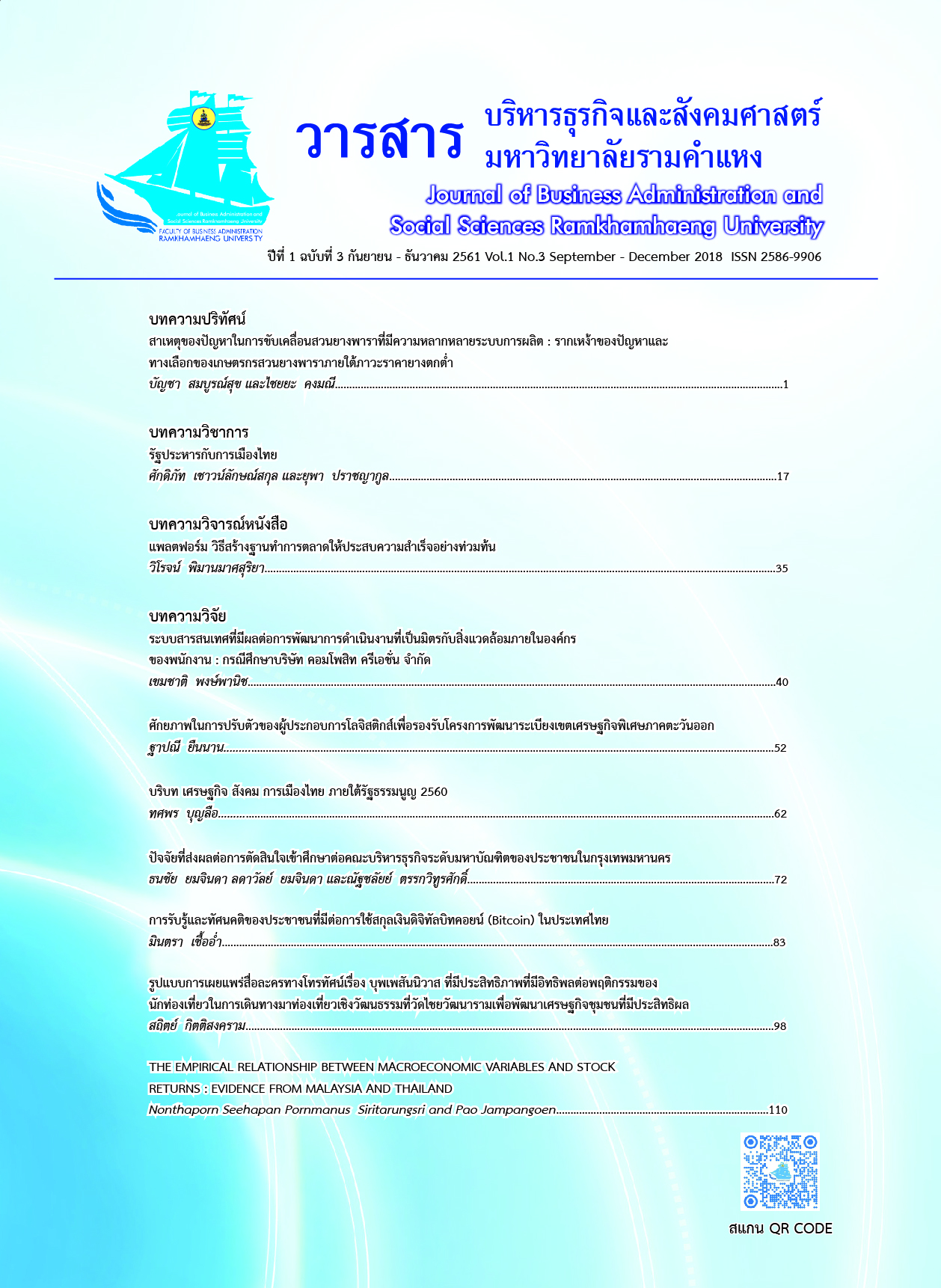THE EMPIRICAL RELATIONSHIP BETWEEN MACROECONOMIC VARIABLES AND STOCK RETURNS: EVIDENCE FROM MALAYSIA AND THAILAND
Main Article Content
Abstract
The stock returns in emerging markets are described as being highly volatile by the high volatility. However, there are limited studies about the fundamental factors that are driving this volatility level. Employing the (Spell out this acronym) (MSCI) world index and the U.S. 3-month T-bill yield as a proxy to examine the effect of international variables, this paper also investigates the key macroeconomic factors which are exchange rates, interest rates, industrial production and money supply in Malaysia and Thailand to see whether each of these variables can explain the stock returns. By examining a six-variable vector autoregressive (VAR) model, it was the result shows that industrial production can significantly explain the stock returns in both countries. While the U.S. 3-month T-bill, interest rates, and money supply variables can explained Malaysian stock returns, whereas the global indicator, such as like the MSCI, can significantly explained Thai stock returns.
Article Details
เนื้อหาและข้อมูลในบทความที่ลงตีพิมพ์ในวารสารบริหารธุรกิจและสังคมศาสตร์ มหาวิทยาลัยรามคำแหง ถือเป็นข้อคิดเห็นและความรับผิดชอบของผู้เขียนบทความโดยตรง ซึ่งกองบรรณาธิการไม่จำเป็นต้องเห็นด้วย หรือร่วมรับผิดชอบใดๆ
บทความ ข้อมูล เนื้อหา รูปภาพ ฯลฯ ที่ได้รับการตีพิมพ์ในวารสารบริหารธุรกิจและสังคมศาสตร์ มหาวิทยาลัยรามคำแหง ถือเป็นลิขสิทธิ์ของวารสารบริหารธุรกิจและสังคมศาสตร์ มหาวิทยาลัยรามคำแหง หากบุคคลหรือหน่วยงานใดต้องการนำบทความทั้งหมดหรือส่วนหนึ่งส่วนใดไปเผยแพร่ต่อ หรือเพื่อกระทำการใดๆ จะต้องได้รับอนุญาตเป็นลายลักษณ์อักษรจากวารสารบริหารธุรกิจและสังคมศาสตร์ มหาวิทยาลัยรามคำแหง ก่อนเท่านั้น
References
Abugri, B. A. (2008). Empirical relationship between macroeconomic volatility and stock returns: Evidence from Latin American markets. International Review of Financial Analysis, 17(2), 396-410.
Aggarwal, R., Inclan, C., & Leal, R. (1999). Volatility in Emerging Stock Markets. Journal of Financial and Quantitative Analysis, 34(1), 33-55.
Asprem, M. (1989). Stock prices, asset portfolios and macroeconomic variables in tent European countries. Journal of Banking and Finance, 13(4-5), 589-612.
Boudoukh, J., & Richardson, M. (1993). Stock returns and inflation: A long-horizon perspective. The American Economic Review, 83(5), 1346-1355.
Errunza, V., & Hogan, K. (1998). Macroeconomic determinants of European stock market volatility. European Financial Management, 4(3), 361-377.
Fama, E. F. (1990). Stock returns, expected returns, and real activity. The Journal of Finance, 45(4), 1089-1109.
Fisher, I. (1930). Theory of interest rates. New York: MacMillan.
Gay, R. D. (2016). Effect of macroeconomic variables on stock market returns for four emerging economies: Brazil, Russia, India, and China. The International Business & Economics Research Journal (Online), 15(3), 119.
Hamid, K., Suleman, M. T., Ali Shah, S. Z., Akash, I., & Shahid, R. (2017). Testing the weak form of efficient market hypothesis: Empirical evidence from Asia-Pacific markets.
Harvey, C. R. (1991). The world price of covariance risk. Journal of Finance, 46(1), 111-157.
Humpe, A., & Macmillan, P. (2009). Can macroeconomic variables explain long-term stock market movements? A comparison of the US and Japan. Applied Financial Economics, 19(2), 111-119.
Kandel, S., & Stambaugh, R. F. (1996). On the predictability of stock returns: an asset‐allocation perspective. The Journal of Finance, 51(2), 385-424.
Khil, J., & Lee, B. S. (2000). Are common stocks a good hedge against inflation? Evidence from the Pacific-rim countries. Pacific-Basin Finance Journal, 8(3-4), 457-482.
Kim, K. H. (2003). Dollar exchange rate and stock price: evidence from multivariate cointegration and error correction model. Review of Financial economics, 12(3), 301-313.
Khan, M. N. , Tantisantiwong, N., Fifield, S. G., & Power, D. M. (2015) The relationship between South Asian stock returns and macroeconomic variables, Applied Economics, 47(13), 1298-1313.
Pebbles, G., & Wilson, P. (1996). The Singapore economy. Cheltenham, UK: Edward Elgar.
Quadir, M. M. (2012). The effect of macroeconomic variables on stock returns on Dhaka stock exchange. International Journal of Economics and Financial Issues, 2(4), 480.
Rahman, A. A., Sidek, N. Z. M., & Tafri, F. H. (2009). Macroeconomic determinants of Malaysian stock market. African Journal of Business Management, 3(3), 95.
Wongbangpo, P., & Sharma, S. C. (2002). Stock market and macroeconomic fundamental dynamic interactions: ASEAN-5 countries. Journal of Asian Economics, 13(1), 27-51.


